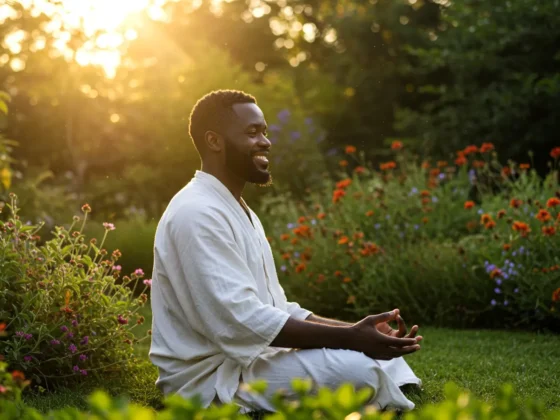Alright Fit Fellows, so you’ve gotten a handle on the external noise – maybe you’re crushing stress and finally getting some decent sleep. That’s awesome! You’ve essentially prepped the ground. Now, it’s time to plant some seriously powerful seeds for a truly sharp mind, and that’s where diving into mindfulness and positive thinking comes in. Forget the fluffy stuff; these are legit techniques for getting a grip on what’s going on inside your head and directing that mental energy where you want it to go.
Think about it: mindfulness is really just about paying attention, fully and completely, to what’s happening right now, without getting caught up in judging it. It’s about being present. That might mean feeling the pavement under your feet when you walk, the flow of air in and out of your lungs, or really tasting your food instead of just shovbling it in while you scroll through your phone. This simple act of noticing builds your mental muscle for focus. It’s like decluttering your brain – less random noise means more space to think clearly and, crucially, to choose how you respond to life instead of just reacting on autopilot.
Now, layer in positive thinking, and you’ve got a pretty potent combo. This isn’t about pretending everything’s sunshine and rainbows when it’s clearly pouring rain. It’s more like putting on a different lens. It’s consciously looking for solutions when there’s a problem, finding the lesson in a screw-up, and actually celebrating the small wins. Practices like gratitude or consciously reframing negative thoughts aren’t just feel-good exercises; they’re actively training your brain to bounce back quicker and see possibilities instead of just roadblocks. By deliberately focusing on the good and staying grounded in the present, you build some serious mental toughness – the kind that helps you roll with the punches and actually grow from them.
So, how do you actually do this stuff? Good news – you don’t need a ton of fancy gear or a remote mountaintop retreat.
What You Need to Get Started:
Honestly? Just a willingness to try and a little bit of patience. Consistency is way more important than perfection here. A quiet spot for a few minutes can be helpful, maybe a journal or even just your phone’s notes app. That’s really about it.
The ‘How-To’ Guide:
Let’s break down some practical steps for weaving mindfulness and positive thinking into your day.
Mindfulness in Action:
- Start Small with Focused Breathing: You don’t need to sit cross-legged for an hour. Just take a few minutes, even 60 seconds. Sit comfortably, close your eyes if you like, and just notice your breath. Don’t try to change it, just observe the feeling of air entering and leaving your body. Your mind will wander – that’s okay! The practice is simply noticing it has wandered and gently bringing your attention back to the breath. Do this for a few minutes daily.
- Mindful Everyday Activities: Pick one regular activity – washing dishes, brushing your teeth, walking to your car. Commit to doing just that one thing mindfully. Feel the water, the temperature; notice the sensations in your mouth; feel your feet on the ground. It sounds simple, but it trains your brain to stay present.
- Body Scan: While sitting or lying down, bring your attention slowly through your body, part by part, noticing any sensations without judgment. Start with your toes and move up to the top of your head. This helps you connect with your physical self and anchors you in the present. There are tons of free guided body scans available online.
Cultivating Positive Thinking:
- The Daily Gratitude Practice: This is huge. At the end of each day, or first thing in the morning, list 3-5 things you’re genuinely grateful for. They don’t have to be massive – the taste of your coffee, a funny meme, a comfortable chair. Writing them down or even just thinking about them helps shift your focus to the good stuff.
- Catch and Reframe Negative Thoughts: Our brains are wired with a negativity bias. Start noticing your negative thoughts. When you have one, pause and ask yourself: Is this thought 100% true? What’s another way to look at this situation? What’s a more balanced or helpful thought I could have instead? For example, instead of “I messed that up completely,” try “Okay, that didn’t go as planned. What did I learn from it?”
- Use Affirmations (the Right Way): Affirmations aren’t magic spells. They’re statements you repeat to yourself to reinforce positive beliefs. Make them present tense, positive, and believable. Instead of “I will be confident,” try “I am building confidence every day.” Say them out loud, write them down, or repeat them in your head.
Helpful Tools & Resources:
- Mindfulness Apps: Apps like Calm, Headspace, or Insight Timer offer guided meditations, breathing exercises, and mindfulness1 training. Many have free content. 1.loquieroo.comloquieroo.com
- Journals: A simple notebook can be a powerful tool for gratitude practice, tracking thoughts, and reflecting.
- Guided Meditations: YouTube has a wealth of free guided meditations on various topics, from focus to relaxation.
- Books/Resources on CBT: Learning basic principles of Cognitive Behavioral Therapy can really help with the ‘reframe’ part of positive thinking by understanding common thought patterns.
Bringing mindfulness and positive thinking together is where the real magic happens. Mindfulness helps you notice your thoughts without getting swept away by them, and positive thinking helps you consciously choose which thoughts you want to nurture. It’s a continuous practice, not a one-time fix. There will be days it feels easier than others. But by consistently dedicating even a few minutes each day to these techniques, you’re actively rewiring your brain for greater clarity, focus, and resilience. You’re building an inner fortress that helps you not just weather the storms of life, but actually emerge stronger and sharper on the other side. Keep practicing, keep exploring, and watch your mental landscape transform.

















